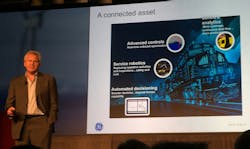As sensors and analytics become an increasing part of manufacturing, the industrial world is turning on its head, according to Jeffrey Immelt, who has spent more than 13 years at the helm of GE. “Every industrial company is going to have to be dedicated to being a software and analytical company,” he said. “Whoever uses data best is going to increasingly decide who’s most successful.”
It would appear that transportation industries are leading the charge for success, embracing the use of sensors and the intelligence they provide to improve maintenance operations, in particular. In his keynote last month at the GE Intelligent Platforms User Summit in Orlando, Immelt described how railroads are using the data. And both Immelt and Jeff Slagle, general manager of propulsion engineering at Delta Air Lines, explained some of what is happening in aviation as well.
There is an increasing surge in demand for technology in the railroad industry for a number of reasons, Immelt said. The tough winter we faced in North America last year hurt on-time delivery for trains. Improving network velocity would be one component for improvement, along with locomotive productivity, fuel efficiency and car dwell time.
Traffic volumes are at a seven-year high, requiring an unparalleled investment for the more than $80 billion railroad industry. Just a 1 percent improvement in operations (what GE refers to as the “power of one”) could provide an annual industrial benefit of $5.6 billion, Immelt explained.
The railroad industry is looking to connected assets to provide sensor analytics, advanced controls, service robotics and automation decision-making. “They know how to measure what the Industrial Internet can deliver,” Immelt said.
Immelt described a situation in which a miniature drone could go around a rail yard, taking pictures of wheels in order to keep track of maintenance issues. “If you can repair things just when they need to be repaired,” he said, “it could save tens of millions of dollars every year for a rail company.”
The airline industry is also seizing the capabilities of connected assets. A typical jet engine from GE will be surrounded by some 30 sensors, the engines gathering terabytes of data on one flight. Improving the fuel efficiency of GE-installed jet engines by just 1 percent could mean an extra $3 billion of profit for the airlines, Immelt said.
A 1 percent fuel loss can cost $14,000 a month for just one jet engine, according to Delta’s Slagle. But an even bigger concern is the cause of that fuel loss, if left untended, will eventually disrupt business. “Aircraft downtime is one of our biggest costs,” he said.
Delta has about 700 mainline aircraft in service at any given time, Slagle said, and the ability to predict when one of those planes needs maintenance can make a huge difference to the business. “We want our aircraft out of service where we can work on them, when we can work on them,” he said.
To do this effectively, Delta is relying on more data and analytics every day, Slagle said, using the “squeaky wheel theory” to service the engines that need servicing. “You can’t listen to 1,400 engines a day. You only want to listen to the ones that are talking to you,” he said. “We can react to the data before a problem escalates.”
The data has made a difference. In 2010, Delta had 20-30 aircraft out of service every day. “It was eating our lunch,” Slagle said. Today, that number is more like seven to 10 aircraft a day.
Where the railroad and airline industries are finding benefits from the data is where GE wants to take all of its businesses, Immelt said. All industrial environments certainly could benefit. “This is not something that you can sit on the sidelines and pretend it’s not for your company,” he asserted. “This is one you can’t afford to miss.”
About the Author
Aaron Hand
Editor-in-Chief, ProFood World

Leaders relevant to this article:
